Tag: Google Assistant
Help and how-to’s for the holidays
by Maps on Dec.17, 2020, under 3D Models, Argentina, Australia, Brazil, California, Denmark, England, Germany, Google Earth News, Google Earth Tips, Google Sky, Google maps, Hawaii, Indonesia, Ireland, Italy, Japan, Kenya, Mexico, Natural Landmarks, Netherlands, Sightseeing, Street Views, USA
Comments Off :Families, Google Assistant, Google Nest, Google TV, maps, Meet, Pixel more...Help and how-tos for the holidays
by Maps on Dec.16, 2020, under 3D Models, Argentina, Australia, Brazil, California, Denmark, England, Germany, Google Earth News, Google Earth Tips, Google Sky, Google maps, Hawaii, Indonesia, Ireland, Italy, Japan, Kenya, Mexico, Natural Landmarks, Netherlands, Sightseeing, Street Views, USA
Comments Off :Families, Google Assistant, Google Nest, Google TV, maps, Meet, Pixel more...Google Maps updates to get you through the holidays
by Dane Glasgow on Nov.17, 2020, under 3D Models, Argentina, Australia, Brazil, California, Denmark, England, Germany, Google Earth News, Google Earth Tips, Google Sky, Google maps, Hawaii, Indonesia, Ireland, Italy, Japan, Kenya, Mexico, Natural Landmarks, Netherlands, Sightseeing, Street Views, USA
This year, we’ve made it easier to find information that helps you stay safe, up-to-date, and connected. Since the start of the pandemic, we’ve added nearly 250 new features and improvements to Google Maps to help you adapt to this new normal—from live busyness information for millions of places, to the ability to easily see critical health and safety information at a glance. And we’re continuing to invest in ways to keep information in Maps fresh, with over 50 million updates made to the map each day. Even as the holidays approach, we don’t plan on slowing down. If you need to be out and about this holiday season, here are four ways that Google Maps can help you get around safely and get things done.
Get around
Whether you’re heading out of town or staying local, keeping a pulse on the latest COVID trends can help you stay safe. Since we launched the COVID layer, it’s helped nearly 10 million people get critical information about COVID-19 right from Google Maps.
We’re rolling out two new improvements in the coming weeks. The updated COVID layer on Android and iOS will soon show more information, including all-time detected cases in an area, along with quick links to COVID resources from local authorities. This is especially handy if you’re heading out of town and need to get up to speed about the local guidelines, testing sites and restrictions in another city.
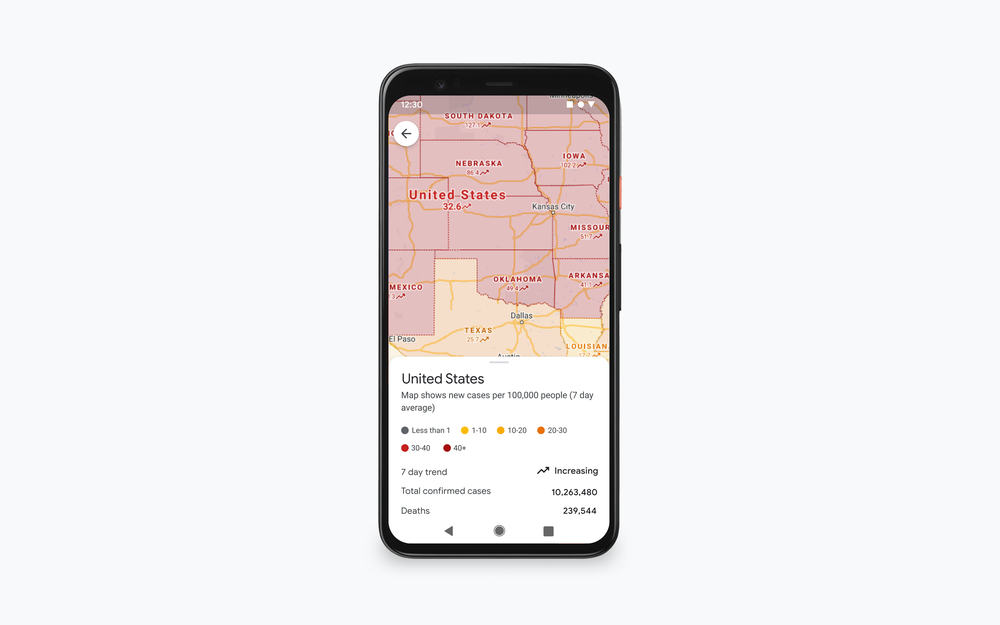
Now you can see all-time detected COVID-19 cases in an area and links to local, authoritative resources right from the COVID layer.
Avoiding holiday crowds might have always been your thing, but this year, we’re making it especially easy for everyone. If you need to take transit, Google Maps can help you more easily social distance with live crowdedness information. On Android and iOS globally, you’ll start seeing how crowded your bus, train, or subway line is right now based on real-time feedback from Google Maps users around the world (wherever data is available).
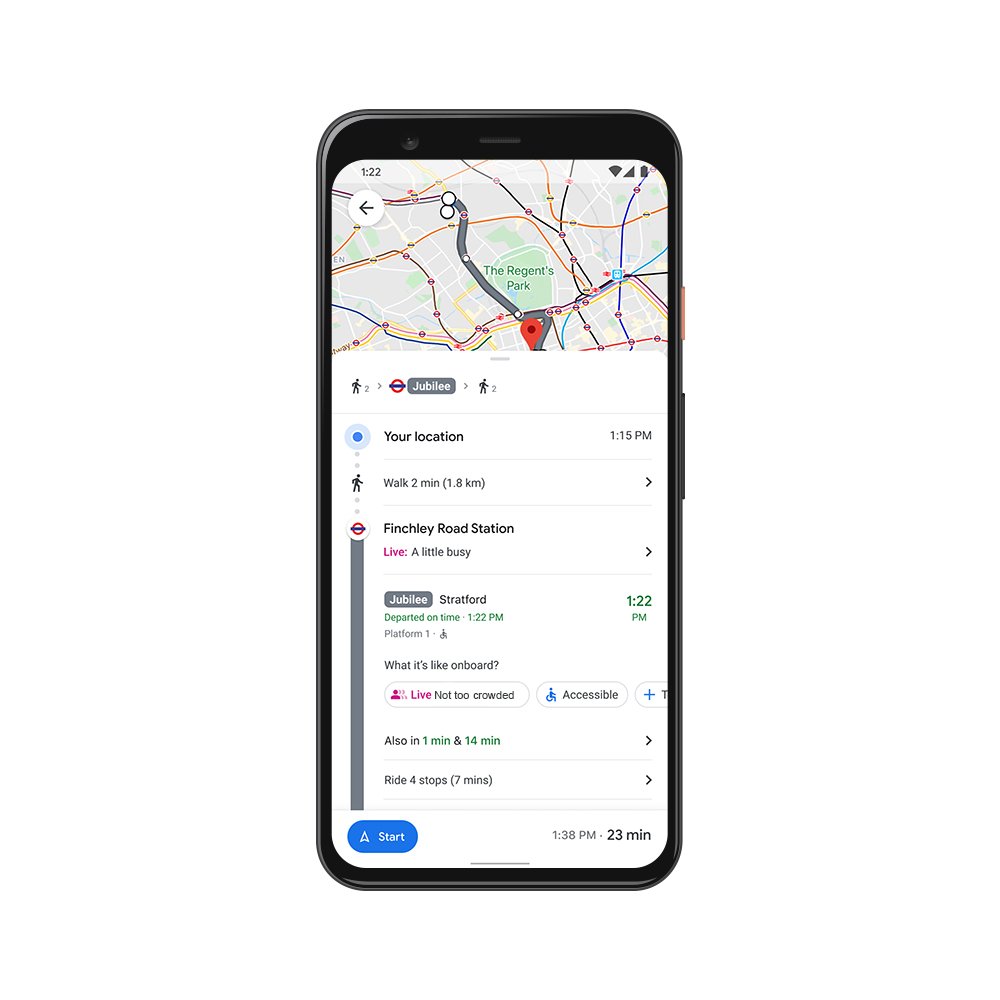
See how crowded your transit line is right now.
The right information, at just the right time
You may be in the mood to cook an elaborate holiday meal—or you may not. If you fall into the latter category, we’re rolling out the ability to see the live status of takeout and delivery orders in the United States, Canada, Germany, Australia, Brazil and India when you book or order from Google Maps on Android and iOS. Now, you can know when to pick up your food, or when you can expect it to arrive at your doorstep. You can also see expected wait times and delivery fees, and easily reorder your favorites right from the Google Maps app. And when it’s safe to head to restaurants, you’ll soon be able to quickly see the status of your reservation in 70 countries around the world.
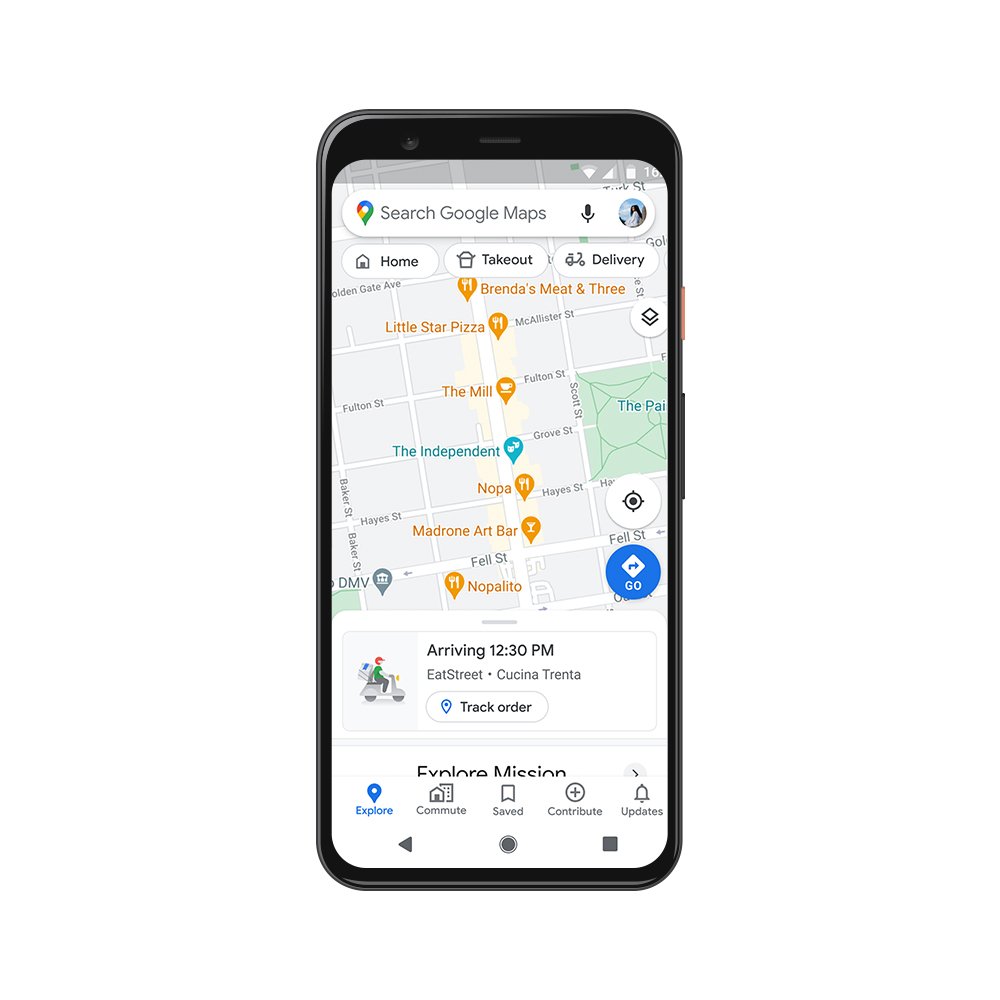
Now you can see the live status of your takeout or delivery order.
Get more done
Even without a global pandemic, the holidays are busy and you may need to spend some time on the road. Last year, we shared an early look at Google Assistant driving mode in Maps, and today, we're starting to roll out an early preview of the improved experience to Android users in English in the U.S.—with more features coming soon.
Thanks to the new driving-friendly Assistant interface, you can easily get more done while keeping your focus on the road. Use voice to send and receive calls and texts, quickly review new messages across your messaging apps in one place, and get a read-out of your texts so you don’t need to look down at your phone—Assistant will even alert you to an incoming call so you can answer or decline with voice. You can also play media from hundreds of providers around the globe, including YouTube Music, Spotify, Google Podcasts and many more. Driving mode makes all of this possible without ever leaving the navigation screen, so you can minimize distractions on the road. To get started with driving mode, begin navigating to a destination with Google Maps and tap on the pop up to get started. Or, head to Assistant settings on your Android phone or say "Hey Google, open Assistant settings.” Then select “Getting around,” choose “Driving mode” and turn it on.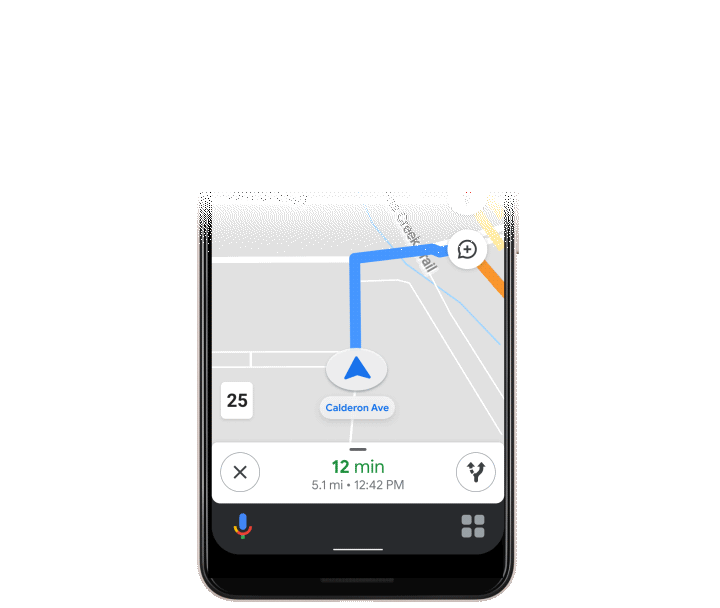
Assistant driving mode in Maps lets you get more done while keeping your focus on the road
While the ways we make life easier for you have changed, our commitment to do this has been there all along. Over the past 15 years, Google Maps has used technology to bring helpful information about the real world right to your fingertips. To make sure that information is as accurate and up-to-date as possible, we rely on 170 billion high-definition Street View images from 87 countries, contributions from hundreds of millions of businesses and people using Google Maps, and authoritative data from more than 10,000 local governments, transit agencies and organizations. We also invest in technical approaches that power some of our most beloved and essential features—from the 20 million places globally that now show popular times data to AR-powered Live View.
Even in a pandemic, more than 1 billion people still turn to Google Maps to navigate their new normal—and our work is far from done. We’re continually working to build new features and services to help all of us emerge from this challenging time stronger than ever. So whatever your plans are this holiday season and no matter how much they’ve changed, Google Maps can make them easier and safer for you.
Data Privacy Day: seven ways we protect your privacy
by Rahul Roy-Chowdhury on Jan.28, 2020, under 3D Models, Argentina, Australia, Brazil, California, Denmark, England, Germany, Google Earth News, Google Earth Tips, Google Sky, Google maps, Hawaii, Indonesia, Ireland, Italy, Japan, Kenya, Mexico, Natural Landmarks, Netherlands, Sightseeing, Street Views, USA
Keeping you safe online is a top priority at Google, especially for the thousands of Googlers who work on privacy and security around the world. Today on Data Privacy Day, we’re sharing some of the many ways we keep you safe online and across our products—from built-in protections to easy tools that keep you in control of your privacy.
1. Keep your passwords safe
Password Manager in your Google Account helps you remember and securely store strong passwords for all your online accounts. With Password Checkup, one click will tell you if any of your passwords are weak—whether you’ve reused them across multiple sites, or if we've discovered they’ve been compromised in a third-party data breach—and we’ll give you the link to change them.
2. Let Google automatically delete your data
With auto-delete for Location History, Web & App Activity and YouTube History, you can choose to have Google automatically and continuously delete your activity and location history after 3 or 18 months. You can also control what data is saved in your account with easy on/off controls in your Google Account, and even delete your data by date, product and topic.
3. Use your favorite Google apps in Incognito mode
Incognito mode has been one of our most popular privacy controls since it launched with Chrome in 2008, and last year we added it to YouTube and Google Maps. Tap from your profile picture to easily turn it on or off. When you turn on Incognito mode in Maps, your activity—like the places you search or get directions to—won’t be saved to your Google Account. When you turn off Incognito mode, you’ll return to a personalized Google Maps experience with restaurant recommendations, information about your commute, and other features tailored to you.
4. Try hands-free privacy controls with the Google Assistant
You can also manage your privacy settings with help from the Assistant. Just say, “Hey Google, delete everything I said to you last week” to delete Assistant activity from your Google Account, or “Hey Google, that wasn’t for you,” to tell the Assistant to forget what it heard if the Assistant responds to something that wasn’t actually a question or request. And to learn how Google keeps your data private and secure, just ask, “Hey Google, how do you keep my data safe?”
5. Browse the web safely with Chrome
Safe Browsing in Chrome automatically protects you from malicious ads and warns you before you visit dangerous sites or download suspicious files. If you use Chrome, your password protections are automatically built-in. We’ll warn you if your username and password have been compromised in a known breach as you log into websites.
6. Check in on your privacy settings across your apps and devices
Data Privacy Day is a great time to check in on your privacy and security settings. Take a Privacy Checkup and we’ll walk you through key privacy settings step-by-step. You can do things like choose what data—such as your location and search history—gets saved to your Google Account or control what ads you see. When you’re finished, head over to Security Checkup for personalized recommendations to help protect your data and devices, like managing which third-party apps have access to your account data.
7. Control what ads you see from Google
We do not sell your personal information to anyone and give you transparency, choice and control over how your information is used. If you’re curious about why you’re seeing an ad, you can click on Why this ad for more information. If you no longer find a specific ad relevant, you can choose to block that ad by using the Mute this ad control. And you can always control the kinds of ads you see, or turn off ads personalization any time in yourAd Settings.
No matter how you use our products, it’s our responsibility to keep your data private and secure. That’s why we work every day to build the best privacy experiences and strongest protections, and we’ll continue our ongoing efforts to make privacy and security simpler for you.
Let Google be your holiday travel tour guide
by Katie Malczyk on Dec.13, 2019, under 3D Models, Argentina, Australia, Brazil, California, Denmark, England, Germany, Google Earth News, Google Earth Tips, Google Sky, Google maps, Hawaii, Indonesia, Ireland, Italy, Japan, Kenya, Mexico, Natural Landmarks, Netherlands, Sightseeing, Street Views, USA
When it comes to travel, I’m a planner. I’m content to spend weeks preparing the perfect holiday getaway: deciding on the ideal destination, finding the cheapest flights and sniffing out the best accommodations. I’ve been dreaming about a trip to Greece next year, and—true story—I’ve already got a spreadsheet to compare potential destinations, organized by flight length and hotel perks.
But the thing I don’t like to do is plot out the nitty-gritty details. I want to visit the important museums and landmarks, but I don’t want to write up a daily itinerary ahead of time. I’m a vegetarian, so I need to find veggie-friendly restaurants, but I’d prefer to stumble upon a good local spot than plan in advance. And, since I don’t speak Greek, I want to be able to navigate transportation options without having to stop and ask people for help all the time.
So I’ve come to rely on some useful Google tools to make my trips work for the way I like to travel. Here’s what I’ve learned so far.
Let Maps do the talking
Getting dropped into a new city is disorienting, and all the more so when you need to ask for help but don’t know how to pronounce the name of the place you’re trying to get to. Google Maps now has a fix for this: When you’ve got a place name up in Maps, just press the new little speaker button next to it, and it will speak out a place's name and address in the local lingo. And if you want to continue the conversation, Google Maps will quickly link you to the Google Translate app.
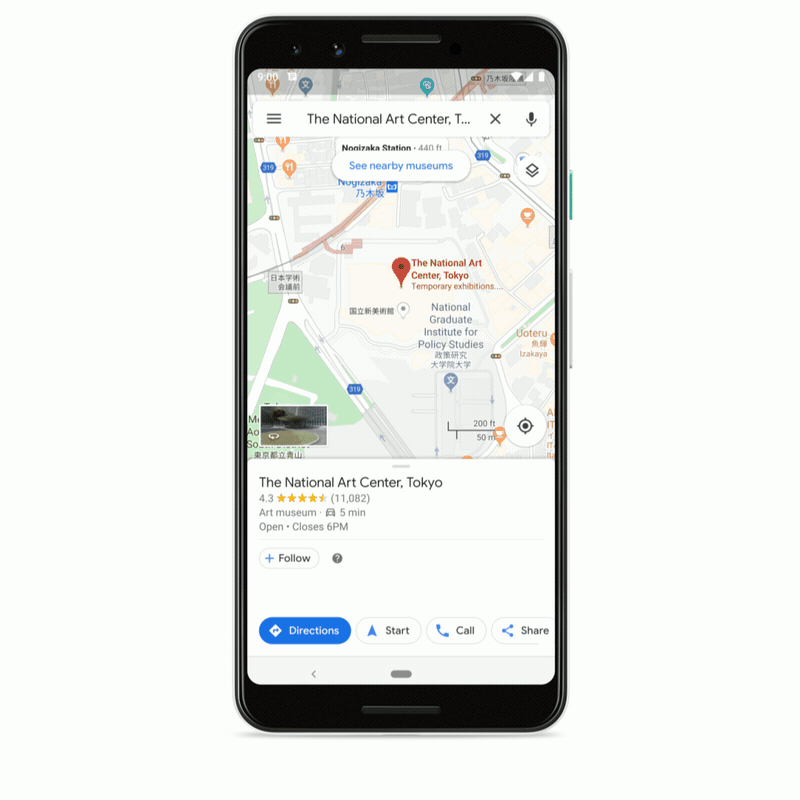
Let your phone be your guidebook
New cities are full of new buildings, new foods and even new foliage. But I don’t want to just see these things; I want to learn more about them. That’s where Google Lens comes in as my know-it-all tour guide and interpreter. It can translate a menu, tell me about the landmark I’m standing in front of or identify a tree I’ve never seen before. So whenever I think, “I wonder what that building is for,” I can just use my camera to get an answer in real time.
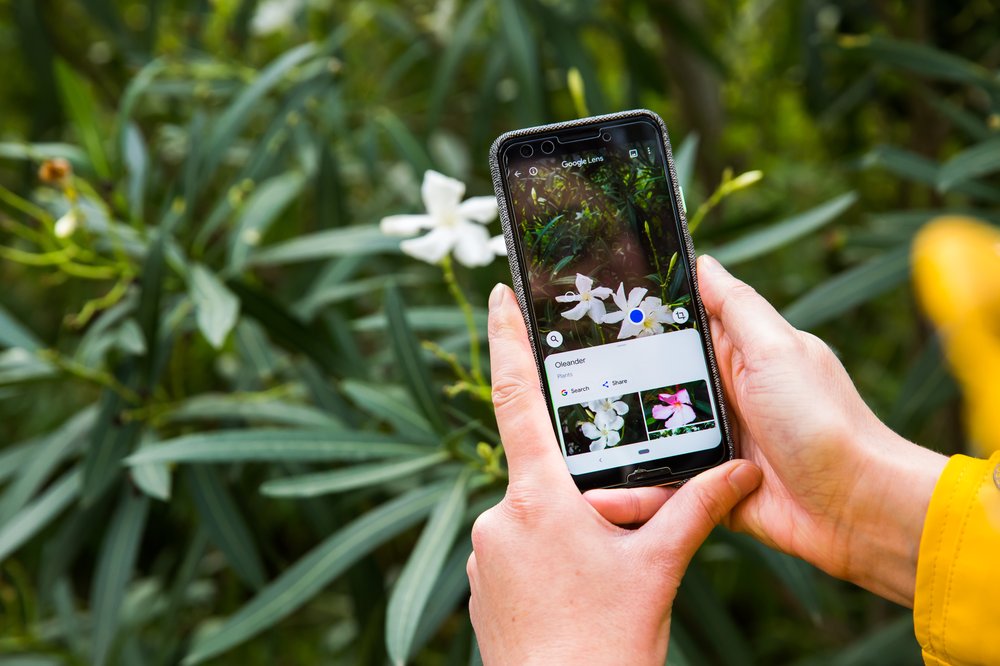
Photo credit: Joao Nogueira
Get translation help on the go
The Google Assistant’s real-time translation feature, interpreter mode, is now available on Android and iOS phones worldwide, enabling you to have a conversation with someone speaking a foreign language. So if I say, “Hey Google, be my Greek translator,” I can easily communicate with, say, a restaurant server who doesn’t speak English. Interpreter mode works across 44 languages, and it features different ways to communicate suited to your situation: you can type using a keyboard for quiet environments, or manually select what language to speak.
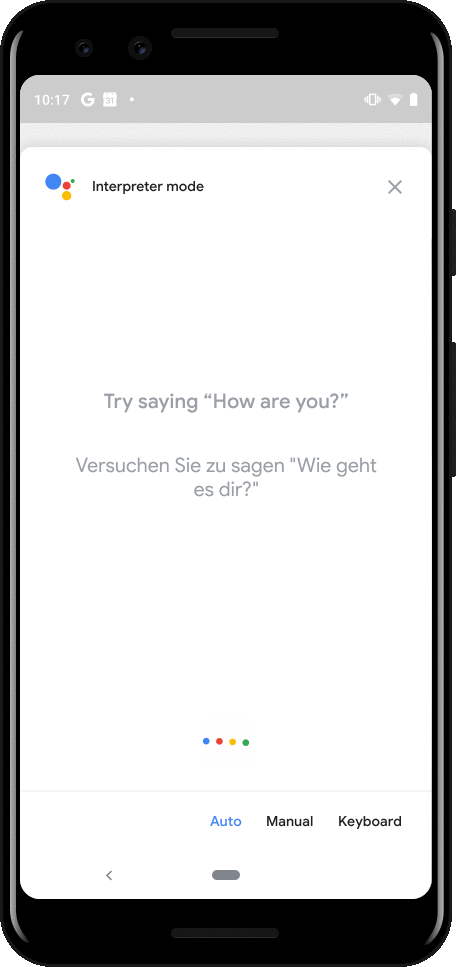
Use your voice to get things done
Typing is fine, but talking is easier, especially when I’m on vacation and want to make everything as simple as possible. The Google Assistant makes it faster to find what I’m looking for and plan what’s next, like weather forecasts, reminders and wake-up alarms. It can also help me with conversions, like “Hey Google, how much is 20 Euros in pounds?”
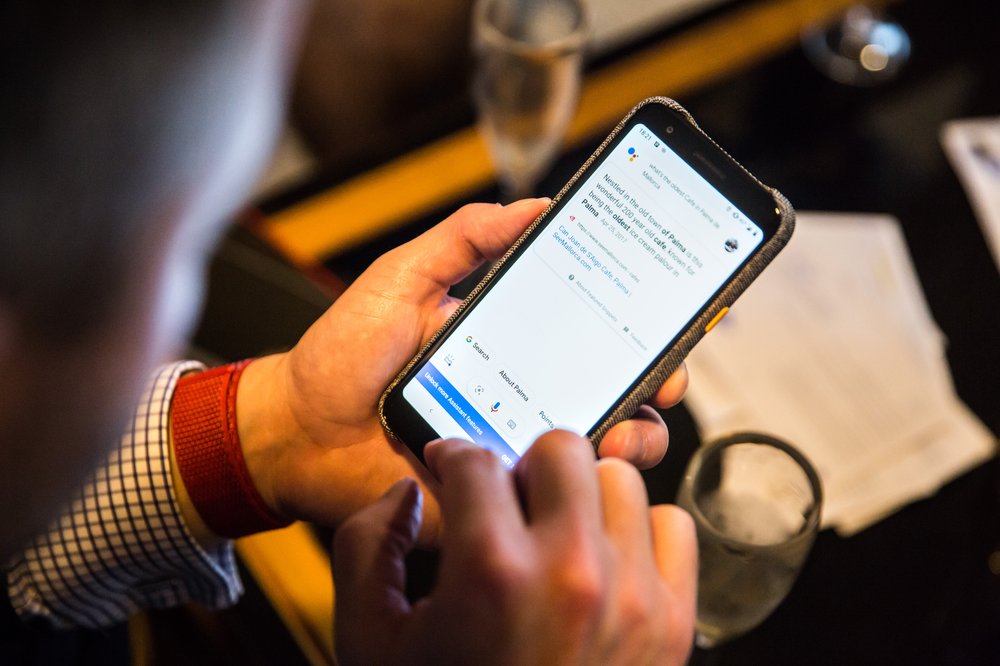
Photo credit: Joao Nogueira
Take pics, then chill
When I’m in a new place, my camera is always out. But sorting through all those pictures is the opposite of relaxing. So I offload that work onto Google Photos: It backs up my photos for free and lets me search for things in them . And when I want to see all the photos my partner has taken, I can create an album that we can both add photos to. And Photos will remind me of our vacation in the future, too, with story-style highlights at the top of the app.
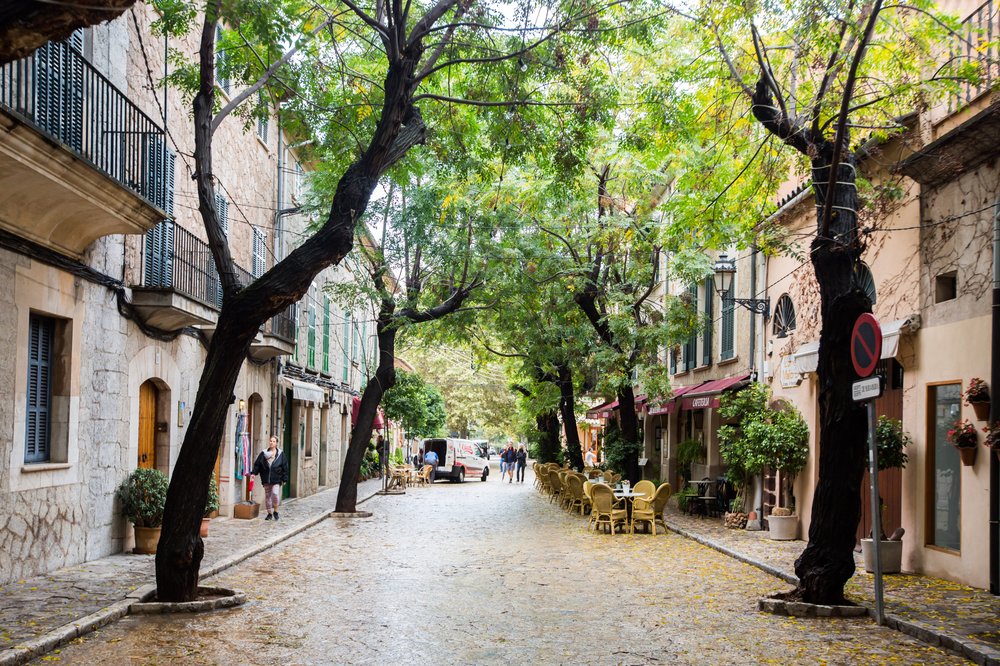
Photo credit: Joao Nogueira
Look up
I live in a big city, which means I don’t get to see the stars much. Traveling somewhere a little less built up means I can hone my Pixel 4 astrophotography skills. It’s easy to use something stable, like a wall, as a makeshift tripod, and then just let the camera do its thing.

Photo credit: DDay
Vacation unplugged
As useful as my phone is, I try to be mindful about putting it down and ignoring it as much as I can. And that goes double for when I’m on vacation. Android phones have a whole assortment of Digital Wellbeing features to help you disconnect. My favorite is definitely flip to shhh: Just place your phone screen-side down and it silences notifications until you pick it back up.

Photo credit: Joao Nogueira
Get into the holiday spirit with Google
Here's how Google products can help this holiday season.
Pixel 3a helped me see my vacation through a new Lens
by Briana Feigon on Aug.24, 2019, under 3D Models, Argentina, Australia, Brazil, California, Denmark, England, Germany, Google Earth News, Google Earth Tips, Google Sky, Google maps, Hawaii, Indonesia, Ireland, Italy, Japan, Kenya, Mexico, Natural Landmarks, Netherlands, Sightseeing, Street Views, USA
When I was a kid, my mom would tell me on every birthday she wanted me to have a big goal in life: Travel to as many countries as my years on Earth. And though I'm far from that ambitious target, my mom did instill a major travel bug in me.

Settling in at the Casa Oaxaca hotel.
But no matter where I travel, I struggle with the same issues many people face: pricey phone bills, subpar photos, a language barrier and, well, getting extremely lost.
So when I traveled to Oaxaca, Mexico last month, I sought out ways to combat these typical tourist problems. And thanks to my Pixel 3a, I was able to make real progress for the next time I visit more countries on my bucket list. Here’s how I did it.
Navigating on Maps without pricey data fees
Even when I’m traveling, I like to be able to use my phone the same way I would at home. (Meaning, a lot.) For this trip, I decided to set my phone up with Google Fi so I could have unlimited international usage and great coverage. At the end of my trip, my phone bill netted out to be a fraction of my typical charge when I travel internationally.
Thanks to my cheaper data plan, I was also able to navigate with help from Maps. I’d never admit it myself, but some people might say I’m bad at directions. (Okay, a lot of people might say that.) In any case, I really leaned into using Live View in Google Maps, a tool that literally has a big blue arrow staring at me on my screen, pointing me exactly in the direction I should go. Even when in rural areas, outside of cell service, I was grateful to be able to use Google Maps in offline mode—like when I visited the Monte Alban ruins.
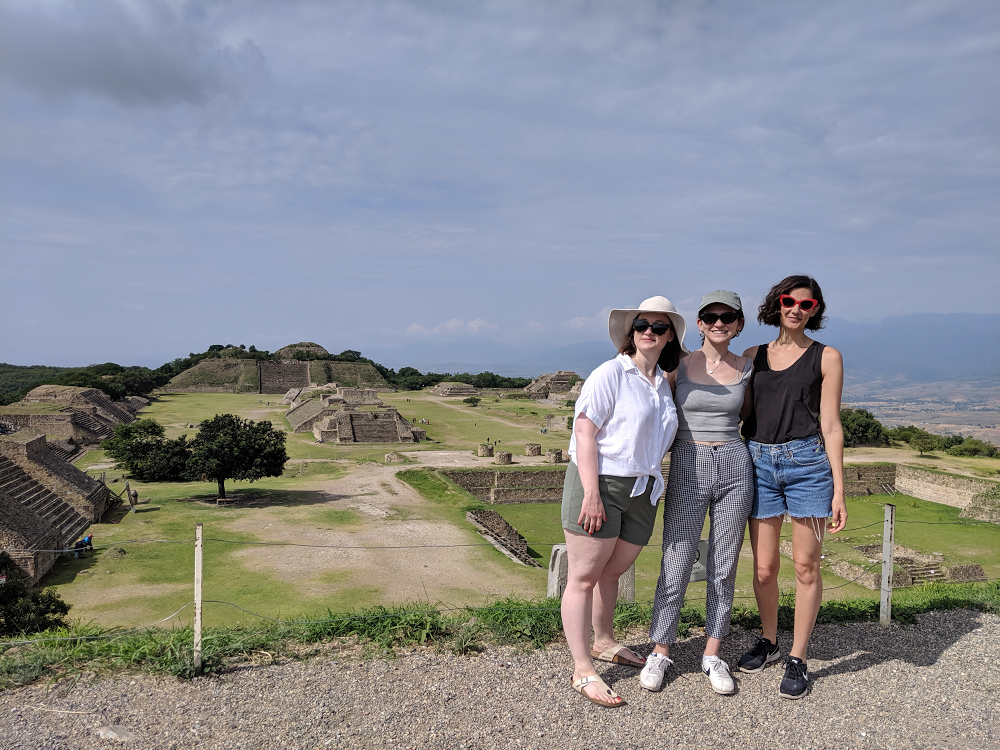
Taking in the beauty of Monte Alban with friends.
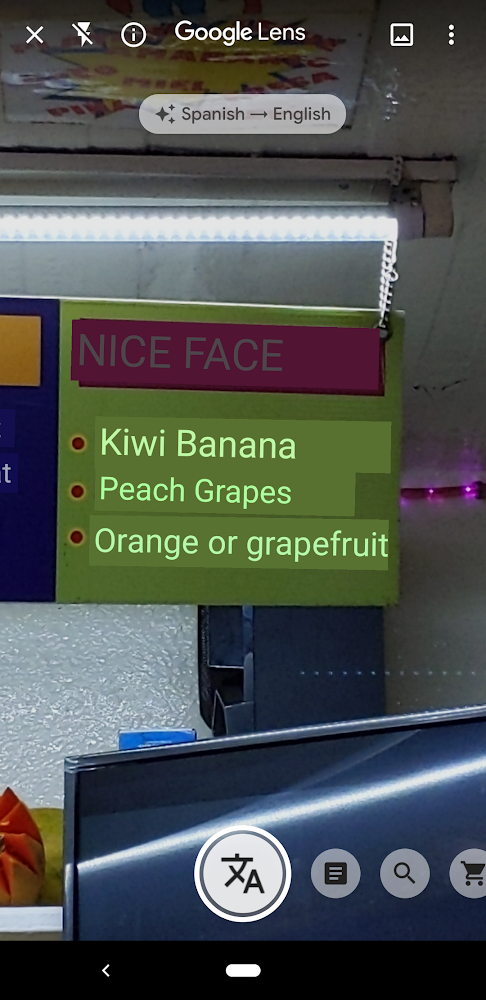
When ordering a juice from a mercado stand, I was able to use Translate in Lens to decipher many of the blends, opting for a juice that promised benefits for my skin.
A new way to break down the language barrier
I’m ashamed to say my Spanish isn’t great, so I put the Pixel 3a to the test. Could it magically help me speak a new language?
Within the camera app, there’s a nifty feature in Google Lens that allows you to hover over text in another language for real-time translations. This came in handy in bustling markets, local restaurants and juice stands that only had menus in Spanish. Even if you don’t have a Pixel phone, you can download the Google Lens app on other Android or iOS devices to try it out yourself.
The Google Assistant also came in handy when I needed language help. It was easy to ask the Assistant questions like, “Hey Google, how do you say ‘where is the bathroom’ in Spanish?” and get help converting costs from pesos to dollars.
Taking my vacation photos to the next level
In a city as beautiful as Oaxaca, I knew I’d be leaning heavily on the camera quality of the Pixel 3a. I snapped photos throughout a cooking demo making tortillas from scratch, and used features like portrait mode and Night Sight to make the most out of my vacation pics. Here are just a few highlights:
My Pixel 3a was the ultimate tour guide
I know, I know, it’s just a phone, but I have to say I feel indebted to my Pixel 3a for showing me such a special time in Oaxaca. I think I’ll take it to my next dream travel destination: Japan.
What’s for dinner? Order it with Google
by Maps on May.24, 2019, under 3D Models, Argentina, Australia, Brazil, California, Denmark, England, Germany, Google Earth News, Google Earth Tips, Google Sky, Google maps, Hawaii, Indonesia, Ireland, Italy, Japan, Kenya, Mexico, Natural Landmarks, Netherlands, Sightseeing, Street Views, USA
French fries, lettuce wraps, massaman curry, chicken wings, cupcakes—I could go on. When I was pregnant with my son last year, my cravings were completely overpowering. Lucky for me, I didn’t have to jump into the car and go to my favorite restaurants to get my fill—food delivery services saved my bacon on more occasions than I’d be comfortable admitting to the world.
Ever since then, I’ve counted myself as one of the millions of people who regularly order food for home delivery. Starting today, we’re making it even easier to get food delivered to your doorstep.
Find food and order faster
Now you can use Google Search, Maps or the Assistant to order food from services like DoorDash, Postmates, Delivery.com, Slice, and ChowNow, with Zuppler and others coming soon. Look out for the “Order Online” button in Search and Maps when you search for a restaurant or type of cuisine. For participating restaurants, you can make your selections with just a few taps, view delivery or pickup times, and check out with Google Pay.
Let the Google Assistant handle dinner
To use the Assistant on your phone to get your food fix, simply say, “Hey Google, order food from [restaurant].” You can also quickly reorder your go-to meal with some of our delivery partners by saying, “Hey Google, reorder food from [restaurant].” The Assistant pulls up your past orders, and in just a few seconds, you can select your usual dish.
Now's the perfect time to let Google help with your cravings. So, what are we ordering tonight?